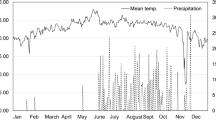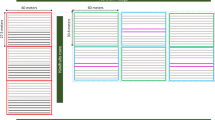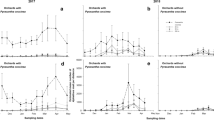Abstract
In field experiments over a period of five years the effects of farming systems and habitat structure were investigated on staphylinid assembly in Central European apple and pear orchards. The investigated farms were placed in three different geographical regions with different environmental conditions (agricultural lowland environment, regularly flooded area and woodland area of medium height mountains). During the survey, a total number of 6,706 individuals belonging to 247 species were collected with pitfall traps. The most common species were: Dinaraea angustula, Omalium caesum, Drusilla canaliculata, Oxypoda abdominale, Philonthus nitidulus, Dexiogya corticina, Xantholinus linearis, X. longiventris, Aleochara bipustulata, Mocyta orbata, Oligota pumilio, Platydracus stercorarius, Olophrum assimile, Tachyporus hypnorum, T. nitidulus and Ocypus olens. The most characteristic species in conventionally treated orchards with sandy soil were: Philonthuss nitidulus, Tachyporus hypnorum, and Mocyta orbata, while species to be found in the same regions, but frequent in abandoned orchards as well were: Omalium caesum, Oxypoda abdominale, Xantholinus linearis and Drusilla canaliculata. The species Dinaraea angustula, Oligota pumilio, Dexiogya corticina, Xantholinus longiventris, Tachyporus nitidulus and Ocypus olens have a different level of preferences towards the conventionally treated orchards in clay soil. The species composition of the staphylinid fauna in apple and pear orchards could not be considered uniform. The environmental conditions and the soil together have a significant influence upon the richness of species, and the cumulative effects of these factors can modify even the dominance structures of the communities.
Similar content being viewed by others
References
Andersen A. 1991. Carabidae and Staphylinidae (Col.) frequently found in Norwegian agricultural fields. New data and review. Fauna Ser. 38: 65–76.
Andersen A. 2000. Long term developments in the Carabid and Staphylinid (Col. Carabidae and Staphylinidae) fauna during the conversion from conventional to biological farming. J. Appl. Entomol. 124: 51–56. DOI 10.1046/j.1439-0418.2000.00438.x
Balog A. & Markó V. 2007a. Chemical disturbances effects on community structure of rove beetles (Coleoptera: Staphylinidae) in Hungarian agricultural fields. N. West. J. Zool. 3: 67–74.
Balog A. & Markó V. 2007b. Rove beetles (Coleoptera: Staphylinidae) in Central European apple and pear orchards — comparative studies of species richness, abundance and diversity. J. Plant Prot. Res. 47: 309–321.
Balog A., Markó V. & Ferencz L. 2008. Patterns in distribution, abundance and prey preferences of parasitoid rove beetles Aleochara bipustulata (L.) (Coleoptera: Staphylinidae, Aleocharinae) in Hungarian agroecosystems. N. West. J. Zool. 4: 6–15.
Balog A., Markó V. Kutasi C. & Ádám L. 2003. Species composition of ground dwelling Staphylinid (Coleoptera: Staphylinidae) communities in apple and pear orchards in Hungary. Acta Phytopathol. Entomol. Hung. 38: 181–198.
Basedow T. & Kollát I. 1997. Vermehrungskoeffizienten von Populationen der Carabidae und Staphylinidae auf Acker-flachen in Hessen. Mitt. Deutsch. Ges. Allg. Angew. Entomol. 11: 601–606.
Birken E.M. & Cloyd R.A. 2007. Food preference of the rove beetle, Atheta coriaria Kraatz (Coleoptera: Staphylinidae) under laboratory conditions. Insect Sci. 14: 53–56. DOI 10.1111/j.1744-7917.2007.00125.x
Bogya S., Szinetár C. & Markó V. 1999. Species composition of spider (Araneae) communities in apple and pear orchards in the Carpathian Basin. Acta Phytopath. Entomol. Hung. 34: 99–121.
Bohč J. 1999. Staphyinid beetles as bioindicatiors. Agric. Ecosyst. Environ. 74: 357–372.
Bryen K. & Wratten S.D. 1985. The responses of polyphagous predators to prey spatial heterogeneity: aggregation by carabid and staphylinid beetles to their cereal aphid prey. Agric. Entomol. 5: 251–259.
Dennis P., Wratten S.D. & Sotherton N.W. 1990. Feeding behavior of the staphylinid beetle Tachyporus hypnorum in relation to its potential for reducing aphid numbers in wheat. Ann. Appl. Biol. 117: 267–276.
Dennis P., Wratten S.W. & Sotherton N.W. 1991. Mycophagy as a factor limiting predation of aphids (Hemiptera: Aphididae) by staphylinid beetles (Coleoptera: Staphylinidae) in cereals. Bull. Entomol. Res. 81: 25–31.
Freude H., Harde, W.K. & Lohse G.A. 1964. Die Käfer Mitteleuropas. Band 4 Staphylinidae I. Goecke & Evers, Krefeld, Germany, 264 pp.
Good J. & Giller P.S. 1991. The diet of predatory Staphylinid beetles — a review of records. Entomol. Mon. Mag. 127: 77–89.
Heyer W. 1994. Occurrence of epigeal predatory arthropods in apple orchards — a basic approach to a risk assessment. Nachrichtenblatt des Deutschen Planzenschutzdienstes 2: 15–18.
Howard J.F., Woodruff R., Beck B.M., Skelley P.E., Schotman C.Y.L. & Thomas M.C. 1998. Checklist and bibliography of the insects of Grenada and the Grenadines. Syst. Entomol. 2: 286.
Krebs C.J. 1989. Ecological Methodology. Harper & Row, New York, 255 pp.
Krooss S. & Schaefer M. 1998. The effect of different farming systems on epigeic arthropods: a five-year study on the rove beetles fauna (Coleoptera: Staphylinidae) of winter wheat. Agric. Ecosyst. Environ. 69: 121–133.
Kutasi C., Balog A. & Markó V. 2001. Ground dwelling Coleoptera fauna of commercial apple orchards. IOBC/WPRS Bull. 24: 215–219.
Luff M.L. & Eyre M.D. 1988. Soil-surface activity of weevils (Coleoptera: Curculionidae) in grassland. Pedobiologia 32: 39–46.
Majzlan O. & Holecová M. 1993. Arthropodocoenoses of an orchards ecosystem in urban agglomeration. Ekológia (Bratisl.) 12: 121–129.
Markó V., Merkl O., Podlussány A, Víg K., Kutasi C. & Bogya S. 1995. Species composition of Coleoptera assemblages in the canopies of Hungarian apple and pear orchards. Acta Phytopath. Entomol. Hung. 30: 221–245.
Mészáros Z., Ádám L., Balázs K., Benedek M.I., Csikai C., Draskovits D.A., Kozár F., Lővei G., Mahunka S., Meszleny A., Mihályi F., Mihályi K., Nagy L., Oláh B., Papp J., Polgár L., Radwan Z., Rácz V., Ronkay L., Solymai P., Soós A., Szabó S., Szabóky C., Szalai-Marzsó L., Szarukán I., Szelényi G., Szentkirályi F., Sziráki G., Szőke K. & Török L. 1984. Results of faunistical and floristical studies in Hungarian apple orchards (Apple Ecosystem Research No. 26.). Acta Phytopath. Entomol. Hung. 19: 91–176.
Oksanen J. & Minchin P.R. 1997. Instability of ordination results under changes in input data order: explanations and remedies. J. Veg. Sci. 8: 447–454.
Perner J. & Malt S. 2002. Zur epigäischen Arthropodenfauna von landwirtschaftlichen Nutzflächen der Unstrutaue im Thüringer Becken. Teil 2: Käfer (Coleoptera). Faun. Abh. Staat. Mus. Tierkd. Dresden 22: 261–283.
Pielou E.C. 1984. The Interpretation of Ecological Data. Wiley, New York, 288 pp.
Shah P.A., Brooks D.R., Ashby J.E., Perry J.N. & Woiwod I.P. 2003. Diversity and abundance of the coleopteran fauna from organic and conventional management system in southern England. Agric. Forest Entomol. 5: 51–60.
Sunderland K.D., Croook N.E., Staccy D.L. & Fuller B.J. 1987 Study of feeding by polyphagous predators on cereal aphids using ELISA and gut dissection. J. App. Ecol. 24: 907–933.
Tóth L. 1982. Magyarország állatvilága — Fauna Hungariae, Holyvák II. — Staphylinidae II VII. Akadémiai Kiadó, Budapest, Hungary, 110 pp.
Tóth L. 1984. Magyarország állatvilága — Fauna Hungariae, Holyvák III. — Staphylinidae III VII. Akadémiai Kiadó, Budapest, Hungary, 142 pp.
Tóthmérész B. 1993. NuCoSA 1.0: Number Cruncher for Community Studies and other Applications. Abstr. Bot. 17: 283–287.
Tóthmérész B. 1995. Comparative analysis of different methods of diversity ordering. J. Veg. Sci. 6: 283–290.
Tóthmérész B. 1996. Nucosa. Programcsomag botanikai, zoológiai és ökológiai vizsgálatokhoz. Scientia, Budapest, 84 pp.
Wardle D.A., Nicholson K.S. & Yeates G.W. 1993. Effect of weed management strategies on some soil-associated arthropods in maize and asparagus ecosystems. Pedobiologia 37: 257–269.
Zerche L. 1994. Die Revision der Oxypoda-Typen aus der Sammlung Claudius Rey im Musée Guimet d’Histoire naturelle de Lyon und einiger anderer Typen der Gattung sowie die Beschreibung von vier neuen Oxypoda-Arten (Coleoptera, Staphylinidae, Aleocharinae). Coleoptera 6: 1–36.
Author information
Authors and Affiliations
Corresponding author
Rights and permissions
About this article
Cite this article
Balog, A., Markó, V. & Imre, A. Farming system and habitat structure effects on rove beetles (Coleoptera: Staphylinidae) assembly in Central European apple and pear orchards. Biologia 64, 343–349 (2009). https://doi.org/10.2478/s11756-009-0045-3
Received:
Accepted:
Published:
Issue Date:
DOI: https://doi.org/10.2478/s11756-009-0045-3




